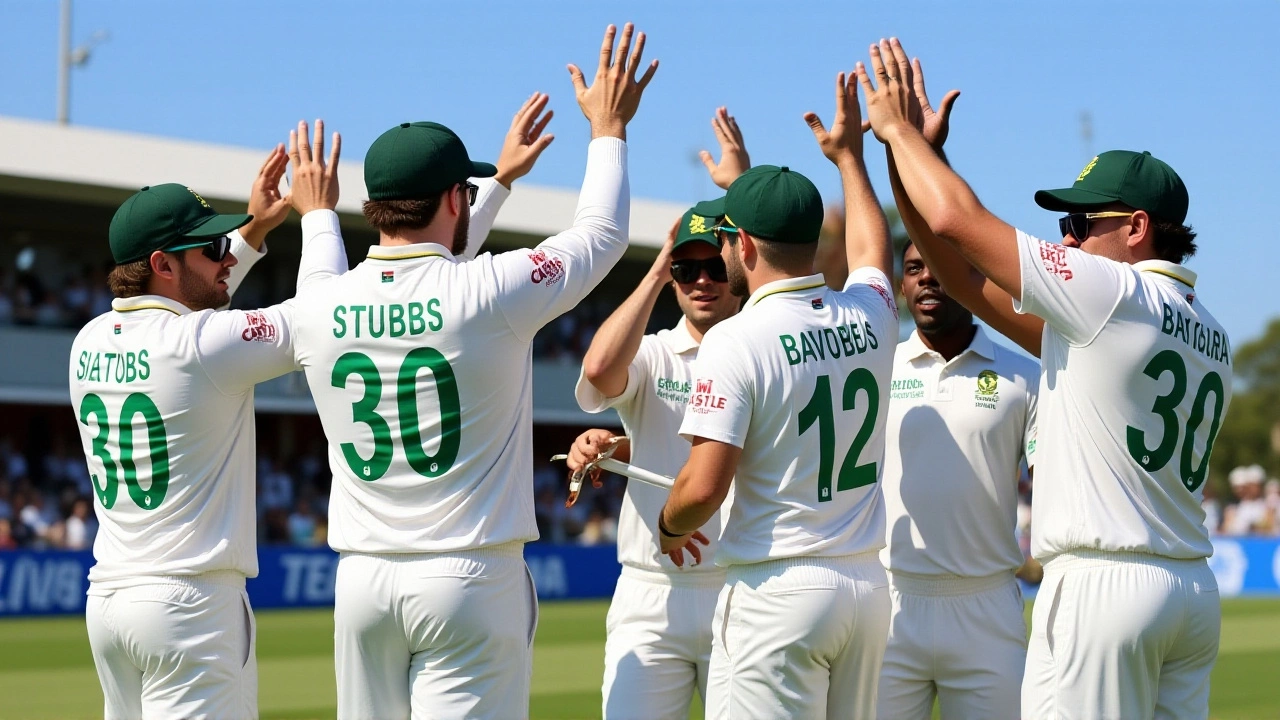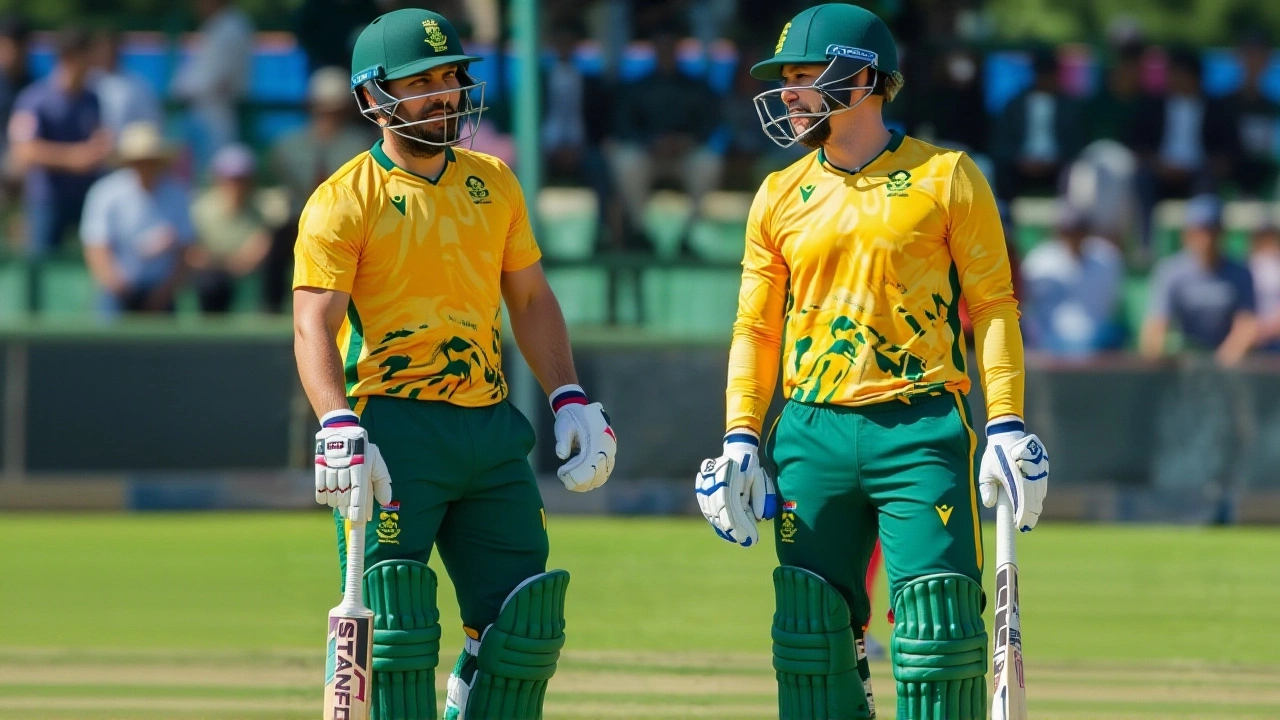When South Africa national cricket team chased down 142 with five wickets and 25 balls to spare on July 14, 2025, at Harare Sports Club, it wasn’t just a win—it was a statement. Rubin Hermann, the understated wicketkeeper-batter, cracked 45 off 37 balls, while Dewald Brevis exploded for 41 in just 17 deliveries, a strike rate of 241.17 that left Zimbabwe’s bowlers stunned. The first match of the 2025 Zimbabwe Tri-Nation SeriesHarare had all the hallmarks of a modern T20 thriller: late-order fireworks, tight death bowling, and a captain’s decision that paid off. Zimbabwe, posting 141/6, had looked competitive thanks to Sikandar Raza’s composed 54 not out off 38, but South Africa’s chase—led by two men playing with fearless intent—made it look easy.
How Zimbabwe Built Their Total
Zimbabwe’s innings began with quiet caution. Openers fell early, but Sikandar Raza steadied the ship like a veteran should. His 54 not out wasn’t flashy, but it was vital—22 of his runs came in boundaries, and he anchored the middle order as the innings lost momentum after the powerplay. Brian Bennett provided a spark with a brisk 30 off 28, but the lower order struggled against South Africa’s disciplined spin and pace. Zimbabwe Cricket, under pressure to deliver competitive performances, had named a 16-man squad on July 10, 2025, featuring a mix of experienced hands like Raza and young talents like Trevor Gwandu. The bowling attack, led by Richard Ngarava (3/35) and Trevor Gwandu (2/15), kept South Africa in check early, but couldn’t contain the final assault.South Africa’s Chase: A Masterclass in Controlled Aggression
The target wasn’t daunting, but the conditions were tricky—slightly slow pitch, variable bounce. South Africa’s openers, Rassie van der Dussen and Reeza Hendricks, got them off to a cautious start. Then came the turning point: Rubin Hermann walked in at 42/2 in the 7th over. He didn’t try to force anything. He picked gaps, rotated strike, and punished loose deliveries. His 45 came with six boundaries and no sixes—a calm counterpoint to what followed. Enter Dewald Brevis. The 22-year-old, already known for his audacity, came in at 90/3 and turned the game on its head. He cleared the ropes twice in his first two overs. One six sailed over midwicket, the next a brutal pull off Ngarava that left the crowd gasping. His 41 in 17 balls was the fastest fifty-equivalent score of the series so far. When Hermann was dismissed in the 16th over, South Africa needed 12 off 25 balls. Brevis finished it with a single to long-on. No drama. No panic.The Umpiring and Match Officials
The match was officiated by two Zimbabwean umpires—Iknow Chabi and Langton Rusere—a nod to local capacity building. Forster Mutizwa served as third umpire, and Ranjan Madugalle of Sri Lanka, a former Sri Lankan captain and ICC veteran, oversaw the match as referee. Madugalle’s presence was more than ceremonial; his role in maintaining standards during a high-stakes, low-budget tournament was crucial. There were no controversial decisions, but the smooth running of the game—especially the pace between overs—was noted by commentators as a sign of improved match management.
The Bigger Picture: A Tournament of Contrasts
What happened next told the real story. New Zealand, the tournament favorites, didn’t just beat South Africa—they dismantled them. They won five of their six matches, including the final on July 26, 2025, by a nerve-jangling three runs. South Africa, despite beating Zimbabwe twice, lost all three matches against New Zealand. Zimbabwe, meanwhile, lost every single game. The gap in quality was stark. New Zealand’s batting depth—led by Devon Conway and Finn Allen—was a class above. South Africa’s T20 squad, announced on July 9, 2025, featured rising stars like Brevis and George Linde (3/10 in the opener), but lacked the experience of a full-strength side. Their win over Zimbabwe was a confidence booster, but not a blueprint.Why This Matters Beyond the Scoreboard
For Zimbabwe Cricket, hosting a tri-series in 2025 was a quiet triumph. After years of financial instability, administrative turmoil, and ICC sanctions, the fact that Harare Sports Club hosted six matches with full crowds, live broadcasts, and ICC oversight speaks volumes. The series was part of Zimbabwe’s long road back to relevance. For South Africa, it was a reminder that their T20 depth is promising but inconsistent. Brevis and Hermann are the future—but they need more high-pressure games. And for New Zealand? They confirmed what everyone already knew: they’re the most dangerous T20 team in the world right now, even without their biggest stars.
What’s Next?
The 2025 Zimbabwe Tri-Nation SeriesHarare is over. But its echoes will linger. South Africa’s next assignment is a home series against England in September. Zimbabwe will look to rebuild ahead of the 2026 T20 World Cup qualifiers. And New Zealand? They’re already eyeing the next big challenge: the ICC T20 World Cup in 2026. The tri-series wasn’t just a warm-up—it was a snapshot of where each team stands.Frequently Asked Questions
How did Rubin Hermann’s performance compare to other wicketkeeper-batters in the series?
Rubin Hermann’s 45 off 37 balls was the highest individual score by a wicketkeeper-batter in the 2025 Zimbabwe Tri-Nation Series. He outperformed New Zealand’s Tom Latham (38 off 32) and Zimbabwe’s Tafadzwa Tsiga (22 off 26), showing greater control under pressure. His strike rate of 121.62 was also among the best for a keeper who didn’t open, highlighting his value as a finisher.
Why did South Africa lose to New Zealand despite beating Zimbabwe twice?
South Africa’s batting lacked consistency against high-quality pace and spin. While they beat Zimbabwe’s weaker attack, New Zealand’s bowling—led by Lockie Ferguson and Mitchell Santner—exploited their middle-order fragility. South Africa lost all three matches against New Zealand by fewer than 25 runs, suggesting they were close but couldn’t close out games under pressure.
What role did George Linde play in South Africa’s success?
George Linde was South Africa’s most economical bowler in the series, taking 3/10 in the opener and finishing with 7 wickets at an economy of 5.82 across three matches. His ability to bowl tight overs in the powerplay and death—often against Zimbabwe’s aggressive middle order—was pivotal. He was the only South African bowler to maintain a sub-6 economy rate in the tournament.
How did Zimbabwe’s squad selection impact their performance?
Zimbabwe relied heavily on Raza and Ngarava, but lacked depth in both batting and bowling. Four players averaged under 15, and their spinners conceded over 8 runs per over. With no experienced all-rounder beyond Raza, they were outgunned in high-pressure chases. Their squad, while talented, lacked the balance needed to compete with top-tier teams.
Was the venue, Harare Sports Club, a factor in the match outcomes?
Yes. The pitch at Harare Sports Club favored spinners as the match wore on, but early on, it was slightly slow and offered grip. Teams that adapted—like New Zealand, with their spin-heavy attack—thrived. South Africa’s reliance on pace early on backfired in the final, while Zimbabwe’s bowlers struggled to adjust to the changing conditions across the series.
What does this series mean for Zimbabwe’s future in international cricket?
Hosting the series successfully, with full crowds and ICC approval, signals Zimbabwe’s return to the international fold. While the results were poor, the infrastructure, broadcast quality, and fan engagement were strong. If they can secure more bilateral series and develop their academy system, Zimbabwe could become a competitive qualifier for future World Cups.
